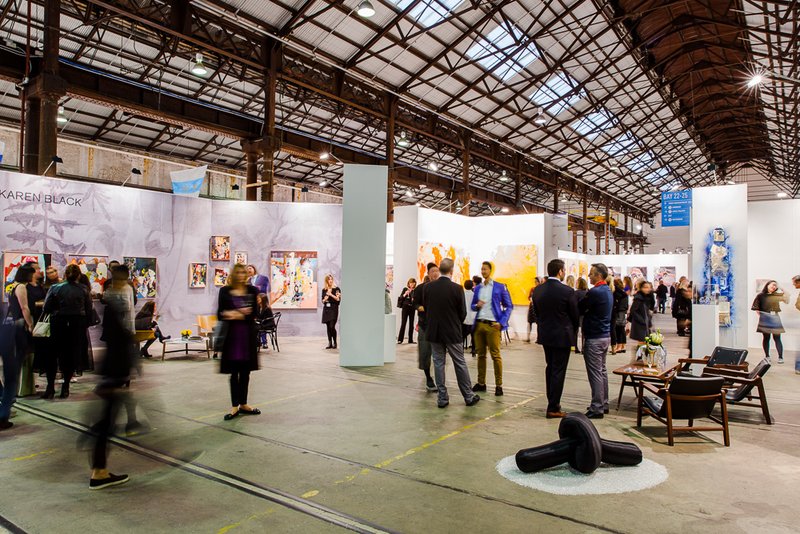Image: Courtesy Sydney Contemporary 2015.
Following the blow dealt to the art market by the global financial crisis in 2008, it has been slow in recovery but is undergoing significant shifts. Many commercial galleries have closed, but new models for selling have emerged. Like biennales, art fairs are proliferating around the world. They are the emergent key marketplace for showcasing artwork for sale and diversifying the collector base. Sydney has just had a spate of simultaneous art fairs but all very different from one another. In their wake, it is good to reflect on the different models they offered.
Sydney Contemporary Art Fair was by far the most ambitious, using the vast complex of Carriageworks in Sydney to stage the four-day event. It showcased 90 Australian and overseas commercial galleries representing the work of mostly contemporary living artists, as well as 3 ARIs and 16 associations or galleries specialising in works on paper. There also were 17 installation artists, over 40 video works and a dozen performance events at the Fair and staged around the Redfern neighbourhood. The tone was high octane and celebratory with yummy food and plenty of bubbly. Separating collectors off for their own VIP opening night proved fruitful and comments by the gallery participants indicated that they were pretty satisfied with the results; $14 million in sales at the last count and rising. This was a 40% increase on the takings from the previous event two years ago.
Spring 1883 at the Establishment Hotel in Sydney followed on the success of an identical fair held last year in Melbourne at the grand old Hotel Windsor, a Melbourne institution. The design of the event is based on the International Art Fair originally started in the Gramercy Hotel in New York. Now 22 years old in the US, this exhibition began as an experiment by just four dealers but grew rapidly and subsequently morphed into the now famous Armory Show with the Modern section devoted to 20th century master artworks; while the Contemporary section is composed of work by living artists. The idea of an art fair being held in an elegant hotel has been replicated in different countries including England and Singapore, Australia being the most recent. Its charm lies in the graciousness of its context and the air of luxury. People loved it.
Though The Other Art Fair launched for the first time in Sydney is also modelled on an international precedent, it was held in a much more youth oriented environment where the 80 unrepresented participating artists personally manned their own small booths at funky Central Park on the edge of the CBD. Running over four days, the fair provided an accessible place to purchase ‘affordable art’ directly from the artists themselves and attracted a very different demographic, including young families with children. Over the past three years the UK has run nine versions of The Other Art Fair, which also acts as an agent in providing artists with the opportunity to sell online as well as brokering connections for them with companies and associations. In Sydney, it was so popular on opening night that the escalators were not coping with the crush and had to be blocked off.
The arts fairs seem to provide an antidote to the online environment which is having a huge impact on the selling of art. Directors of the commercial galleries at Sydney Contemporary had mixed views about the pros and cons of technological change. Most said that large attendances at individual galleries was a thing of the past. Some said their longstanding intimate knowledge about their artists’ development and intentions was being undermined by the instant superficial information and gratification provided by Google. However, they also acknowledged that the web and social media dissolved the tyranny of distance and the marketplace has become truly global. Online purchases are exponentially increasing even amongst seasoned investors and bringing new buyers into the market.
With attendances over four days of more than 30,00 people at Sydney Contemporary and many more thousands at the other two, it seems like the real thing still has ‘punter appeal’.
And the sales figures are making everyone happy.
Tamara Winikoff OAM
Executive Director
National Association for the Visual Arts (NAVA)







